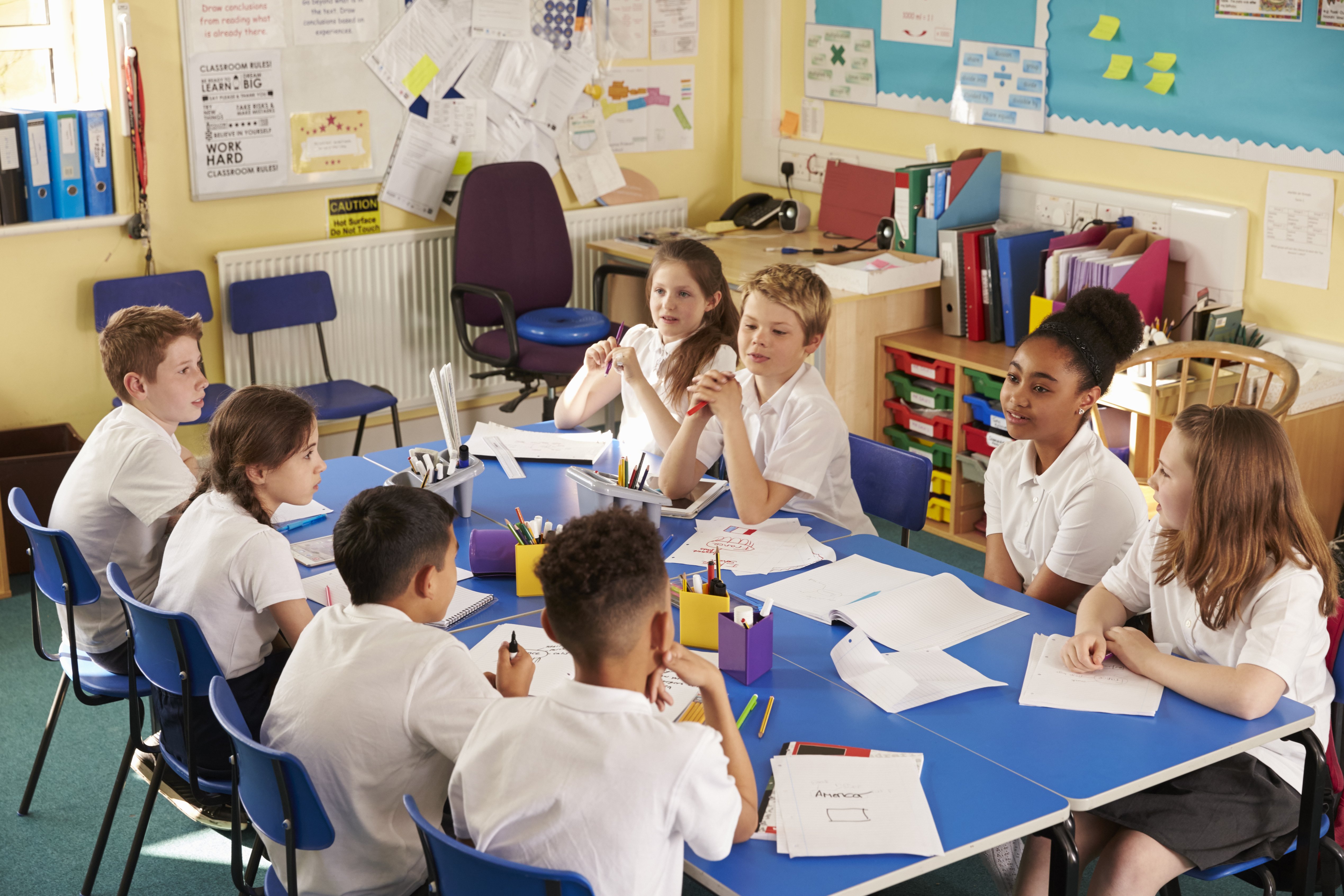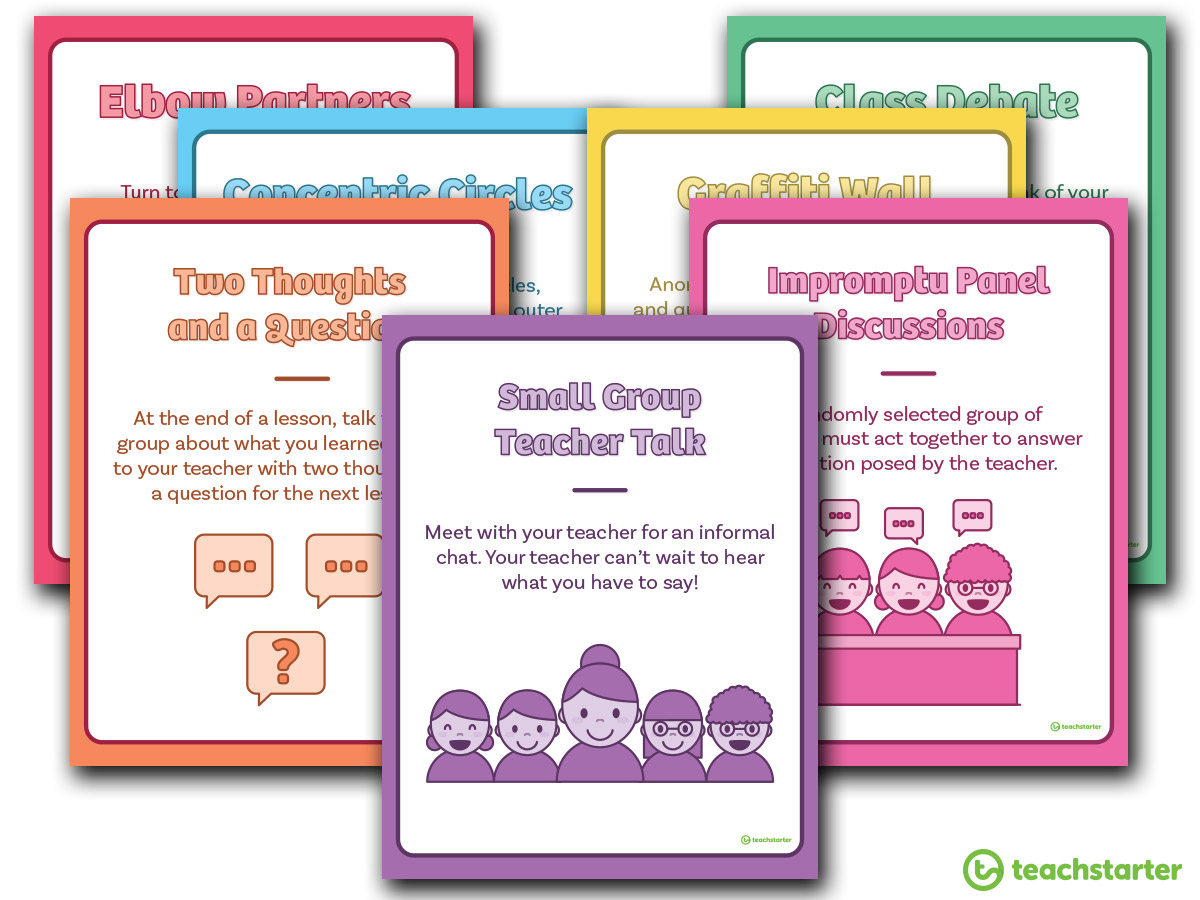Student-led discussion strategies are a great way to boost collaboration in your classroom!
Teaching your students productive ways to discuss their thoughts and ideas with their peers is an incredibly powerful tool.
I can’t think of a better way to encourage students to think more creatively and take ownership of their learning!
As a learning activity, student-led discussion also has many other benefits:
- Students are thinking actively in peer-to-peer discussions.
- Interactions between students build confidence and social skills.
- Movement throughout their learning environment during these discussions help blood flow and engagement.
- Students improve their speaking and listening skills in a variety of situations.

Speaking and Listening Skills
Before you can encourage student-led discussion in your classroom, you need to make sure your students are ready to hone their speaking and listening skills.
Good speakers and listeners should:
- respect that everyone has ideas and opinions
- take turns being the speaker and the listener
- actively listen with their whole body
- ask questions when they don’t understand
- speak confidently in a variety of situations
- speak clearly, and with appropriate volume and pace
- contribute relevant ideas
- express their own point of view about a topic.
If you’re not sure your students are quite up to scratch, my blog 10 Activities for Developing the Skills of Speaking and Listening has some great classroom ideas for building these skills!

8 Student-Led Discussion Strategies for Your Classroom
To get you started, we’ve put together 10 powerful discussion strategies to share ideas and deepen thinking in your classroom!
Once you’ve read through these strategies, you’ll be itching to implement them with your students.
To help you and your students remember these for weeks to come, we’ve also created an amazing Student-Led Discussion Strategies Poster Pack! Display them in your classroom to quickly refer to when you and your students are getting chatty with your learning.
Read ahead for a more in-depth break down of each strategy, and the best ways to use them!
#1 Elbow Partners
We’ll start off with an oldie but a goodie! ‘Elbow partners’ is a great attention-grabbing strategy to use when introducing a new topic or concept to your class.
After your lesson introduction, ask students to turn to their ‘elbow partners’ to discuss their prior knowledge or any questions they may have. After a minute, switch to the other elbow partner and ask them to share what they learned from their first elbow partner!

#2 Concentric Circles
This is a great activity practice sharing opinions on a particular topic.
Have your class stand in two circles, one inside the other. The inner circle turns and faces the outside circle so that everyone has a discussion partner.
Each circle must speak for a side of an argument. For example, for the discussion topic “Cakes are better than cookies” the inner circle could be on the side of cakes, and the outer circle could be on the side of cookies! Start the timer at 30 seconds and say go! Each pair must discuss their opinion for the allotted time.
We have lots of persuasive resources to encourage discussion on concentric circles. Here are some of my favourite persuasive prompts!
[resource:2708854][resource:2708850][resource:2708842][resource:2708838]
At the end of the 30 seconds, the inner circle takes one step to the left and starts their discussion with a new partner!
#3 Two Thoughts and a Question
This collaborative activity encourages students to recognise their understanding and pushes them to reach for more information.

At the end of a lesson, ask your students to quickly get together for 2Ts and a Q. Students then discuss their thinking during the lesson with each other.
Together, each group presents the teacher with two thoughts and a question about the content they have learned that lesson. This is a great way to build on student thinking and can inform the direction of their learning journey!
#4 Impromptu Panel Discussions
This isn’t your typical panel discussion!
An impromptu panel discussion is exactly that – a randomly selected panel of students working together to answer a question posed by the teacher or the rest of the class.
There is only one rule – they must discuss each other’s answers within their own.
Here are some examples of sentence starters students may use during an impromptu panel discussion:
- I agree with ____ because ____.
- I was confused when _____ said _____.
- Another example is ______.
- This makes me think ______.
- I understand why you think that, but _____.
- I’d like to add _____.
A great way to practice this discussion strategy is by projecting an inferential question on the board. Our Inference Scenarios Teaching Resource Pack will inspire your students to observe and discuss what is happening in each image, with the teacher prompting of course! Each of these posters also comes with a worksheet of question prompts to help you out!
Here are a few of the amazing posters available in this resource:
[resource:2719090][resource:2719078][resource:2719086][resource:2719070]
#5 Class Debate
This activity can be done in small groups or as a whole class split into two groups! Give your class the side of ‘for’ or ‘against’ a question posed to the class. The groups have 5 minutes to come up with as many points as they can to argue their side!
They must elect a speaker to represent them. At the end of the 5 minutes, both speakers have the opportunity to stand up in front of the class and present their group’s arguments for 3 minutes.

At the end of the 3 minutes, the students must re-group to work on rebuttal arguments!
#6 Graffiti Wall
This discussion strategy involves students sharing their thoughts with sticky notes.
Who doesn’t love sticky notes?!
In this engaging activity, students have the benefit of being able to remain anonymous, while still sharing ideas and questions.
Here’s how you do it…
- Write a question or the beginning of a sentence on the board, such as “A good learner should…”
- Give students 2 minutes to write as many ideas on sticky notes as they can, sticking them to the board, or graffiti wall, as they go!
- Once time is up, move them on to a related independent task.
- While students are working independently, the teacher can group the sticky notes into ‘like’ ideas.
- Bring the students back to the graffiti wall and discuss the trends with them. Talk through the sticky notes and the ideas they agree or disagree with.
I love this discussion strategy, as it really brings together the students’ thoughts in a way that a simple discussion can’t. Everyone is encouraged to include someone on the wall, so everyone is thinking! Your students get to see how their thinking fits in with their peers.
For more fabulous sticky note ideas, make sure to check out our blog 36 Tricks to Make Learning Stick! Teaching with Sticky Notes!
#7 Small Group-Teacher Talk
Sometimes the best discussion strategies are the easiest. A small group of students meeting with their teacher for an informal chat about a topic or lesson is one of the simplest, yet most effective methods of encouraging students to engage in thoughtful discussion.

The best part about an informal teacher-small group discussion, is that often students aren’t nervous to share their thoughts, as they might be in front of the whole class.
Your students will be sharing their thoughts, challenging their speaking and listening skills, and hearing others’ ideas without even realising they’re doing it!
#8 What’s It For?
A great discussion strategy for introducing new equipment or tactile tools into lessons!
Present the students with a piece of equipment. In teams, each group has to think of a use for the piece of equipment. How will the class use it? What is it for?

The challenge is for each group to think reasonably! They must present suggestions to you that are within the realm of possibility.
Feel free to give each team clues to help them along!
The team which has the closest guess to the truth can have the privilege of using the equipment first!








Comments